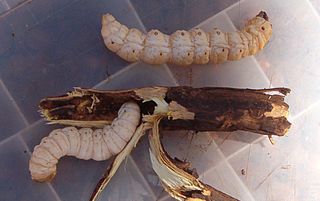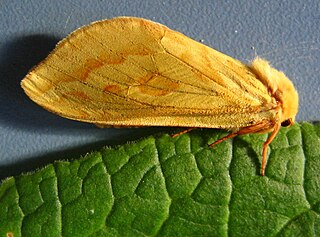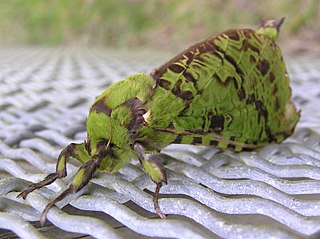
The witchetty grub is a term used in Australia for the large, white, wood-eating larvae of several moths. In particular, it applies to the larvae of the cossid moth Endoxyla leucomochla, which feeds on the roots of the witchetty bush that is widespread throughout the Northern Territory and also typically found in parts of Western Australia and South Australia, although it is also found elsewhere throughout Australia.

The Hepialidae are a family of insects in the lepidopteran order. Moths of this family are often referred to as swift moths or ghost moths.

The ghost moth or ghost swift is a moth of the family Hepialidae. It is common throughout Europe, except for in the far south-east.

Aenetus is a genus of moths of the family Hepialidae. There are 24 described species found in Indonesia, New Guinea, New Caledonia, Australia and New Zealand. Most species have green or blue forewings and reddish hindwings, but some are predominantly brown or white. The larvae feed in the trunks of living trees, burrowing horizontally into the trunk, then vertically down.
The Hepialoidea are the superfamily of "ghost moths" and "swift moths".

Norman Barnett Tindale AO was an Australian anthropologist, archaeologist, entomologist and ethnologist.
Bordaia is a genus of moths of the family Hepialidae. There are five described species, all endemic to Australia.

Fraus is a genus of moths of the family Hepialidae. There are 25 described species, all endemic to Australia.

Oxycanus is a genus of moths of the family Hepialidae. There are 71 described species found in Australia and New Guinea.

Zelotypia is a monotypic moth genus of the family Hepialidae. The only described species is Z. stacyi, the bentwing ghost moth, which is only found in Queensland and New South Wales, Australia. This is a very large species with a wingspan of up to 250 mm. The larva feeds and pupates in the trunks and branches of Eucalyptus.

Abantiades latipennis, known as the Pindi moth, is a species of moth in the family Hepialidae. It may also be referred to as a swift moth or a ghost moth, as this is a common name associated with Hepialidae. Endemic to Australia and identified in 1932, it is most populous in temperate rainforest where eucalypti are prevalent, as the larvae feed primarily on the roots of these trees. Females lay eggs during flight in a scattering fashion. The larvae live for over eighteen months underground, while adult moths survive for approximately one week, as they have no mouthparts with which to feed. The moths are preyed upon by a number of predators, including bats and owls. Brown in colour overall, males are paler and the identifying silver bars of the male's wings are more prominent than those of the female's, with dark margins. Male adults are generally smaller.

Abantiades barcas is a moth of the family Hepialidae. It is endemic to the Australian Capital Territory, New South Wales and Queensland.
Bordaia karnka is a species of moth of the family Hepialidae. It is endemic to Western Australia.
Bordaia moesta is a species of moth of the family Hepialidae. It is endemic to Western Australia.
Bordaia paradoxa is a species of moth of the family Hepialidae. It is endemic to Western Australia.
Bordaia pica is a species of moth of the family Hepialidae. It is endemic to South Australia, Victoria and Western Australia.

Fraus simulans, the lesser ghost moth, is a moth of the family Hepialidae. It is endemic to the Australian Capital Territory, New South Wales, Queensland, South Australia, Tasmania, Victoria and Western Australia.
Trictena argyrosticha is a species of moth of the family Hepialidae. It was described by Turner in 1929, and is endemic to New South Wales and Queensland.
Trictena barnardi is a species of moth of the family Hepialidae. It was described by Norman Tindale in 1941, and is endemic to Western Australia.










